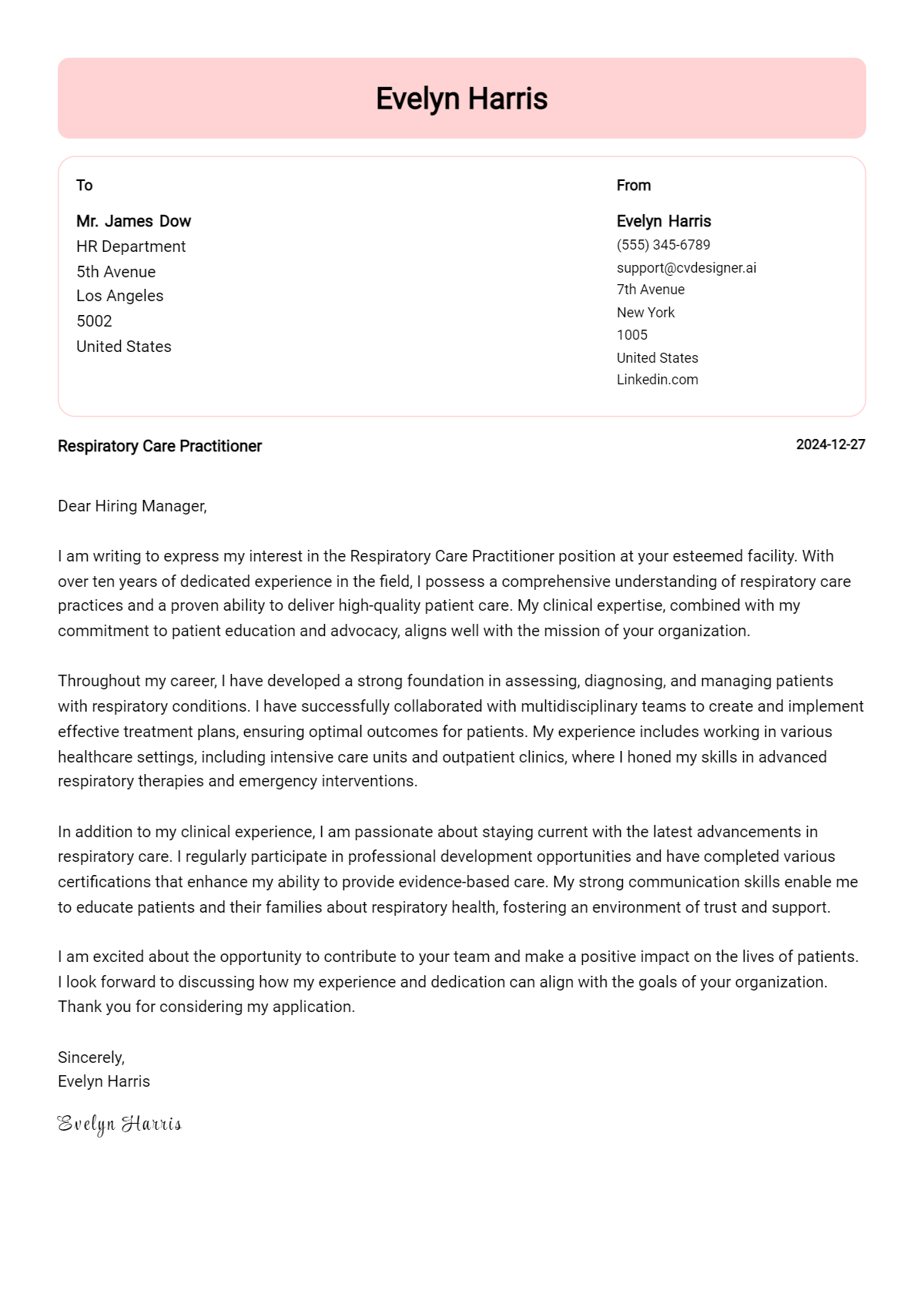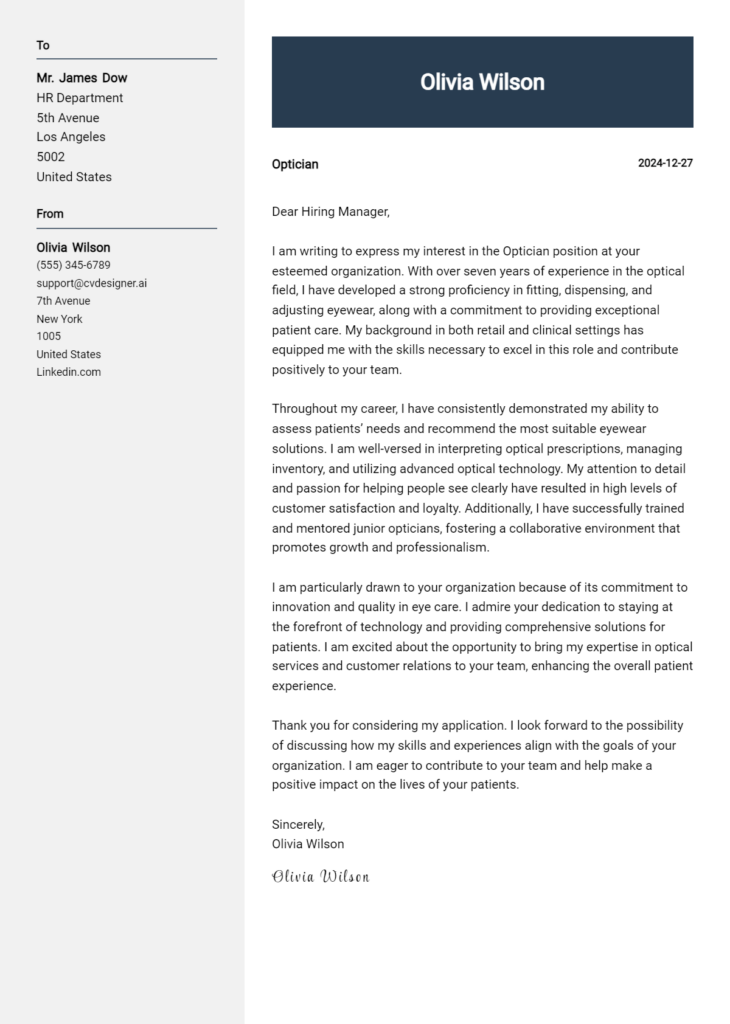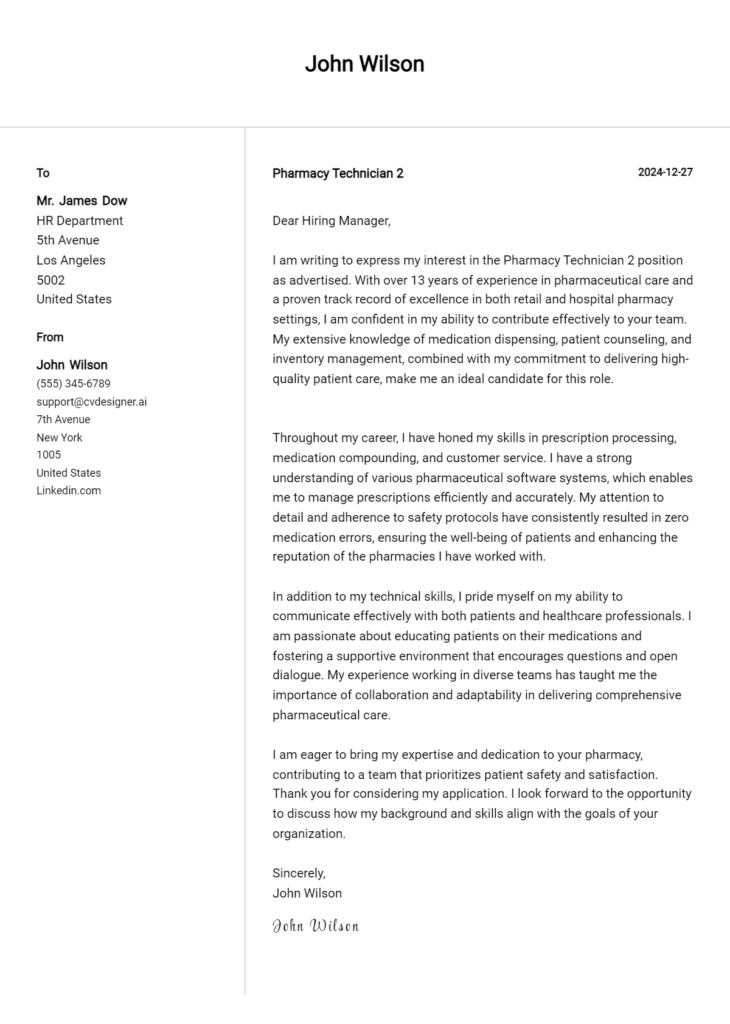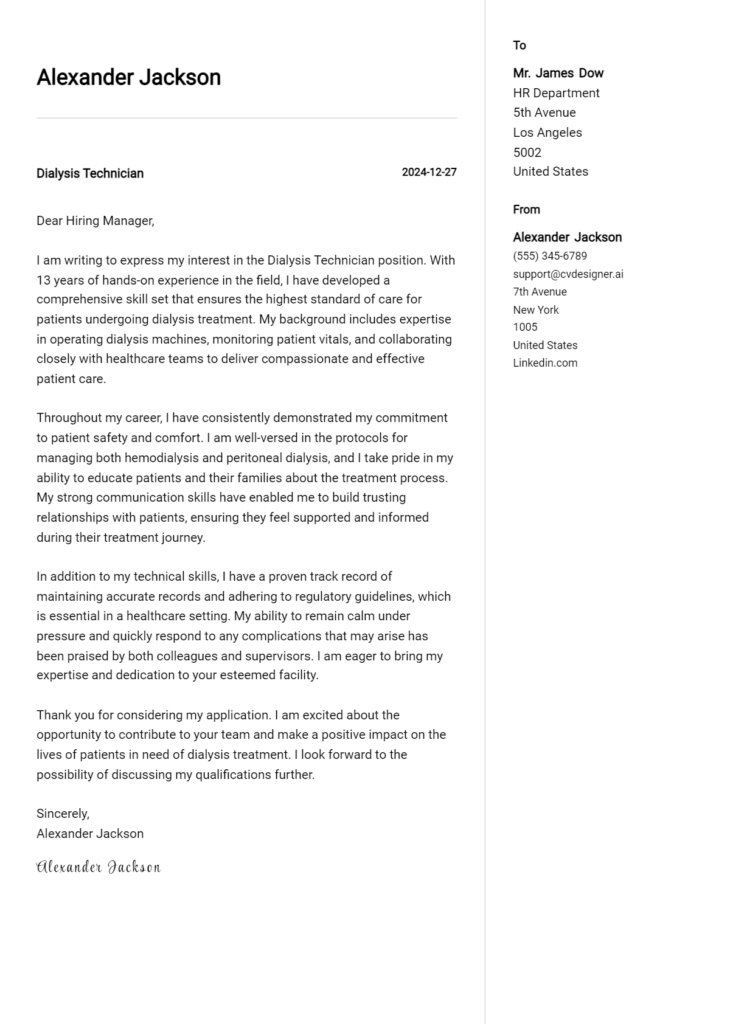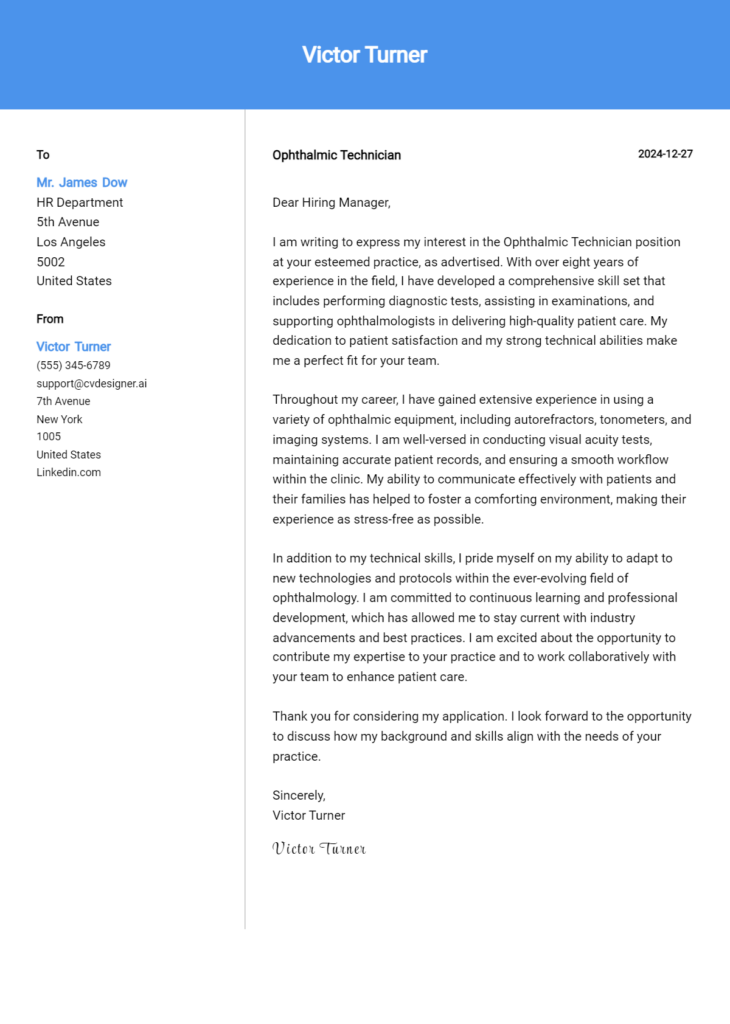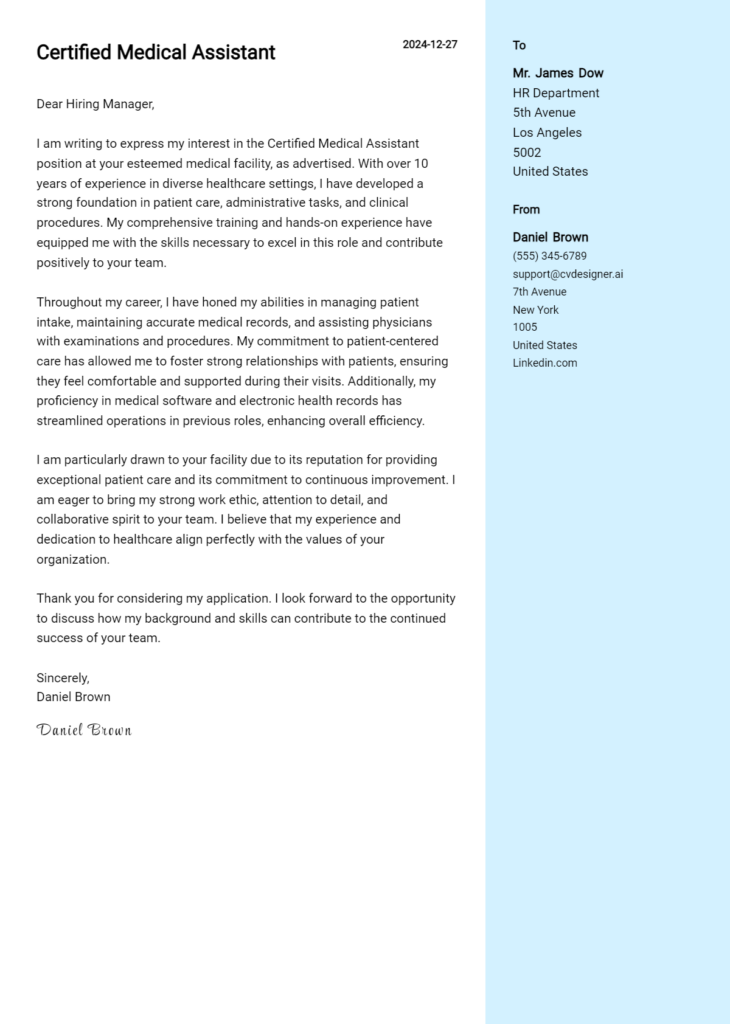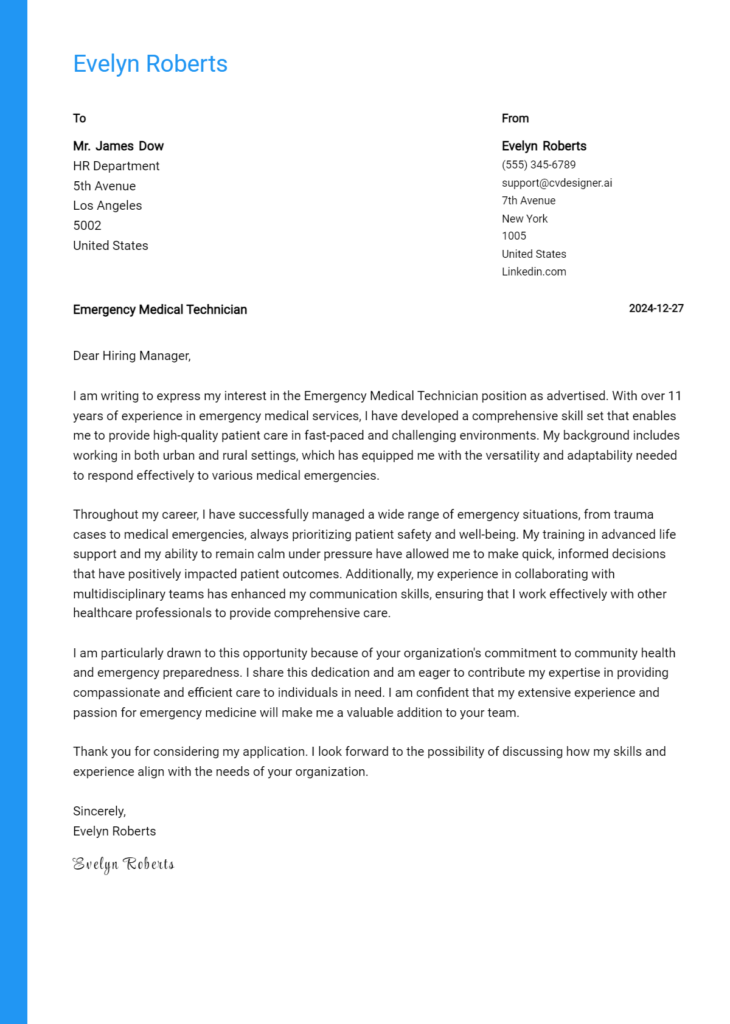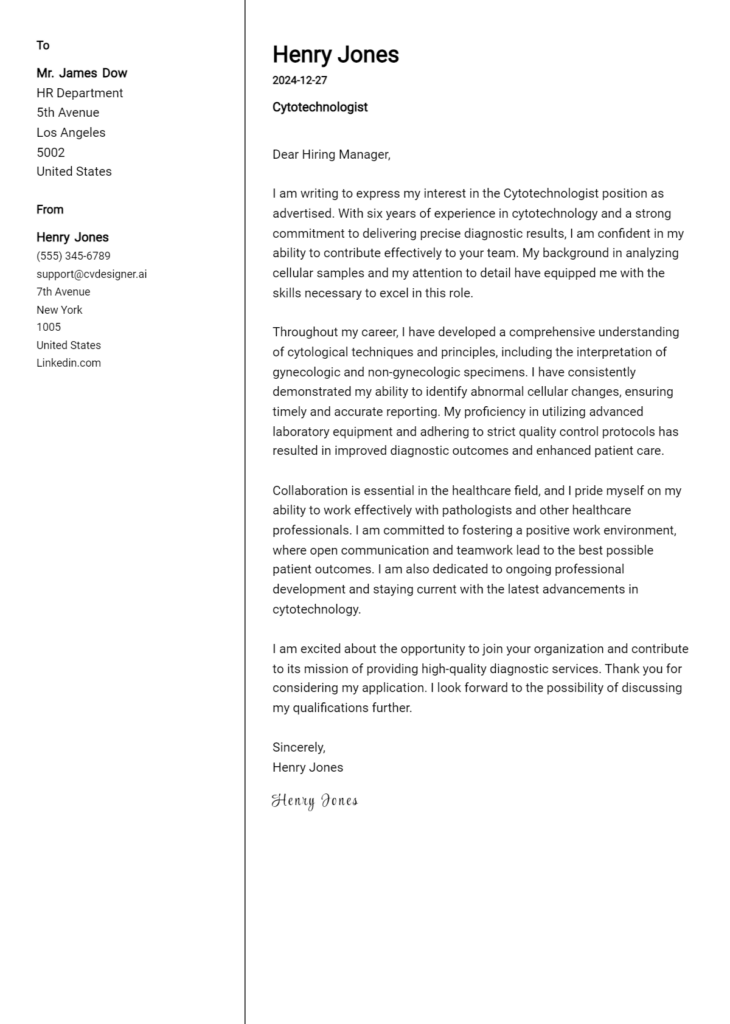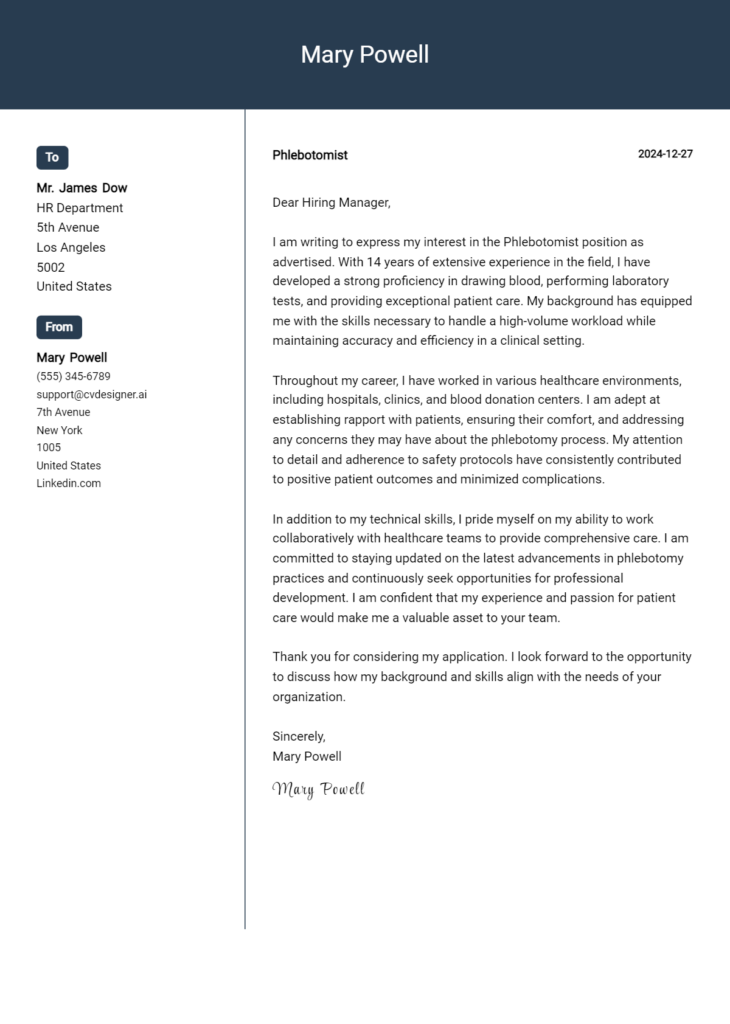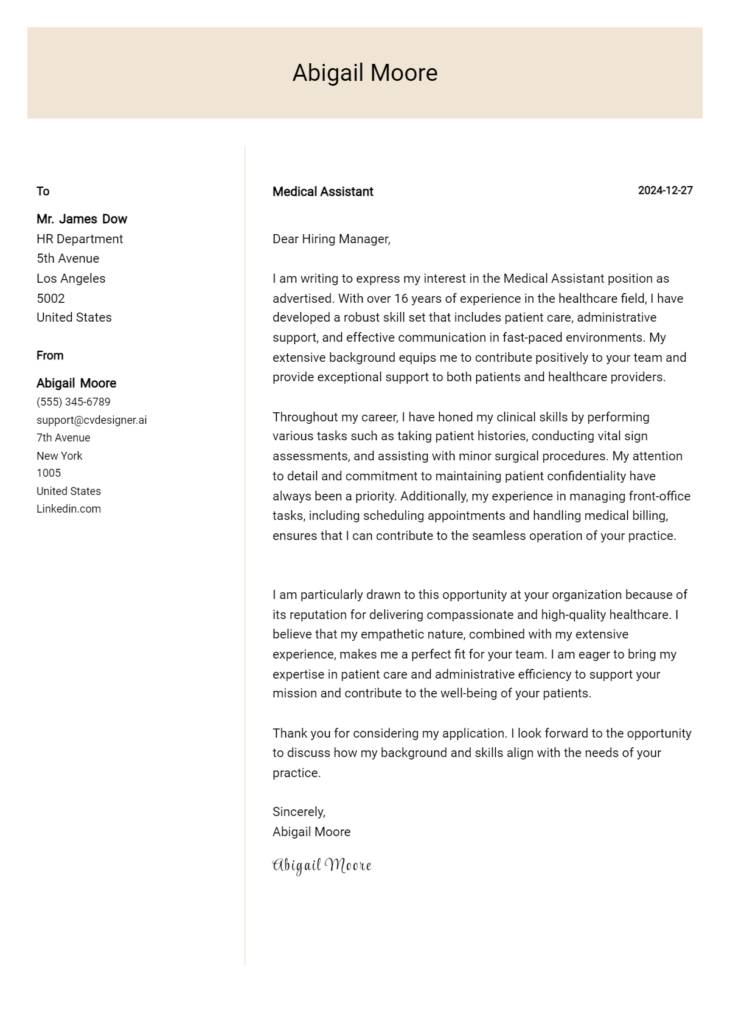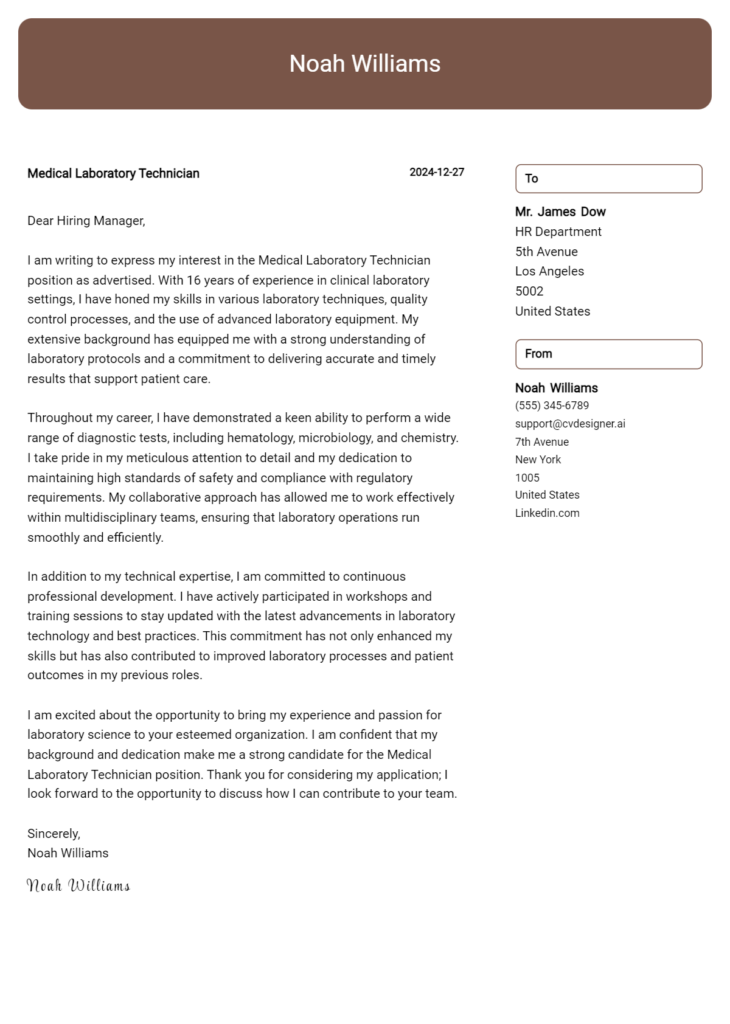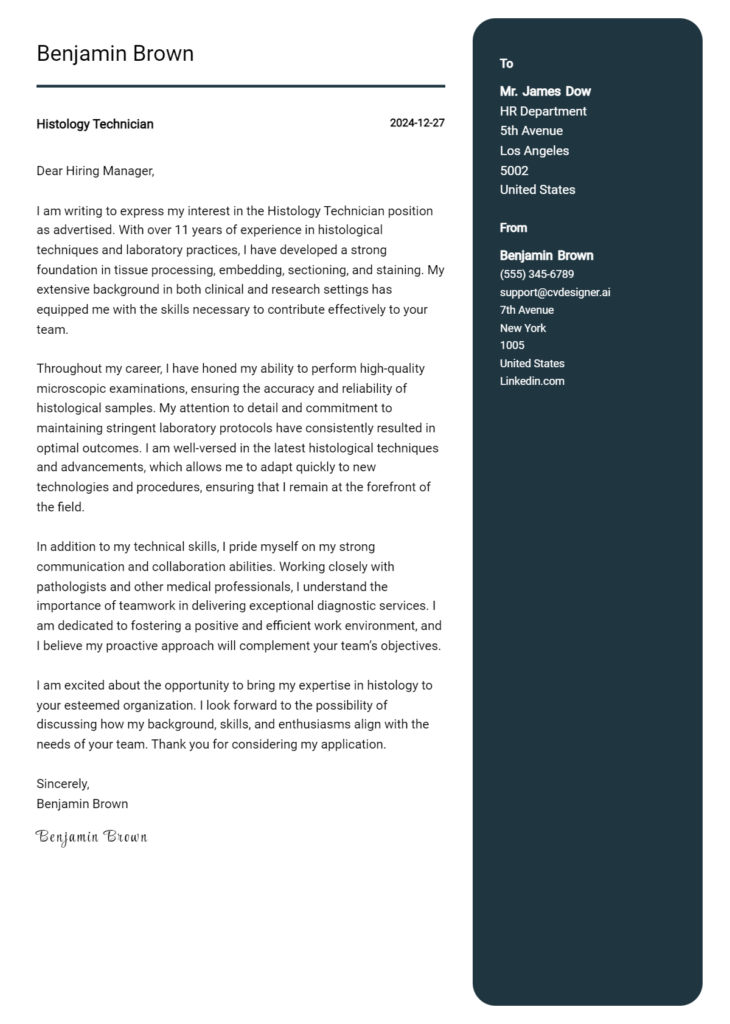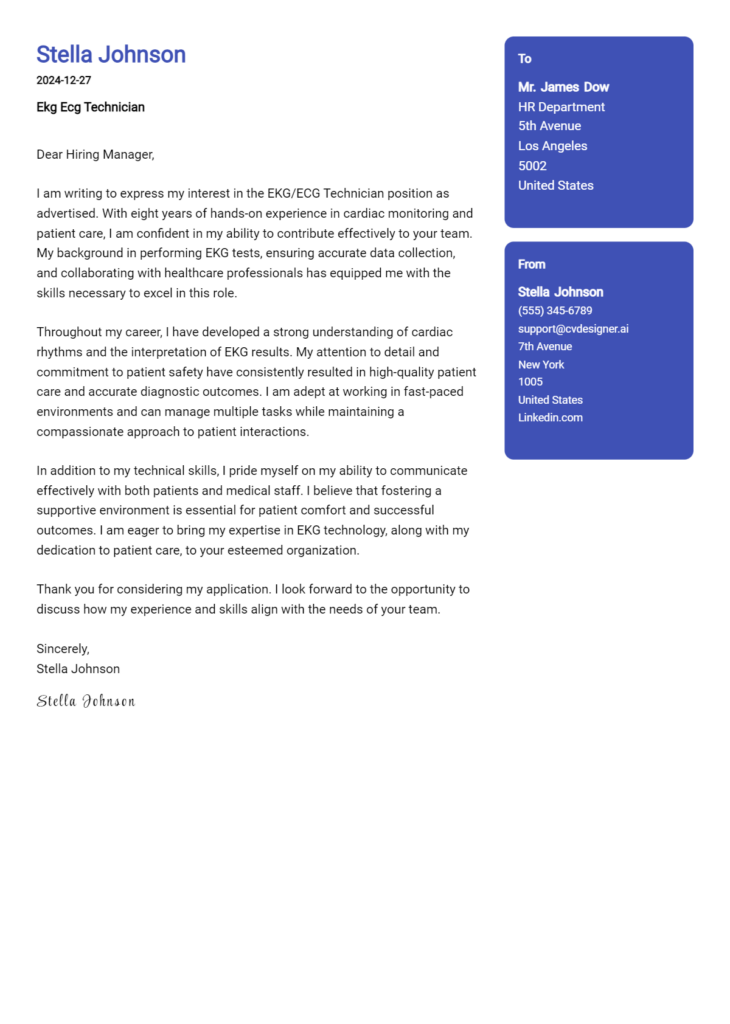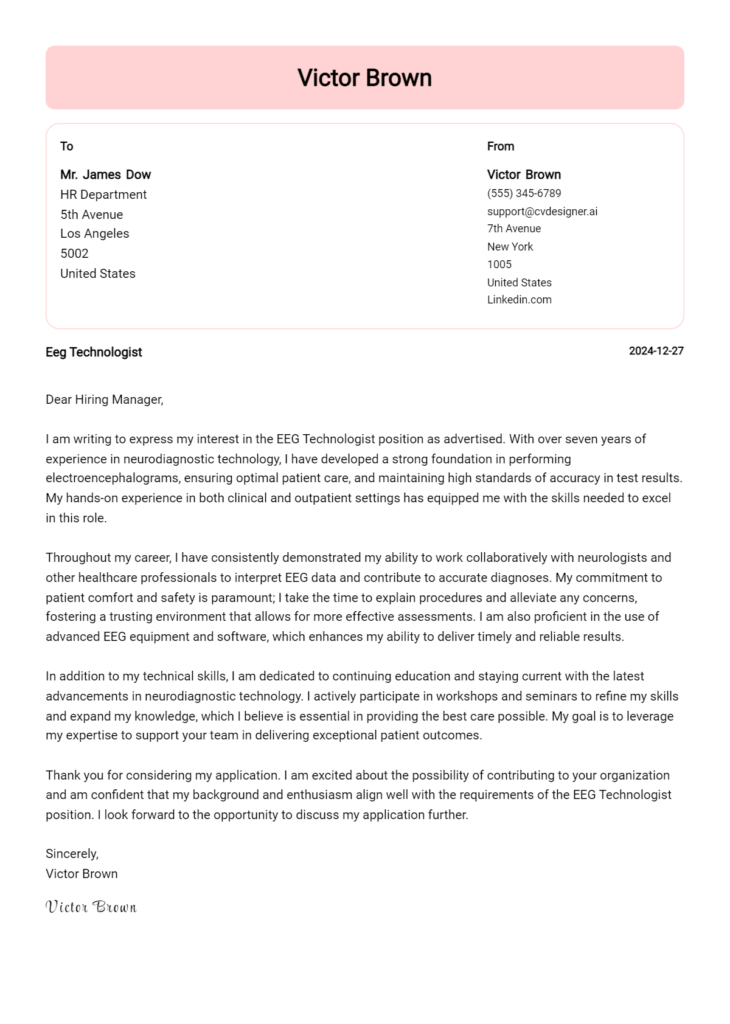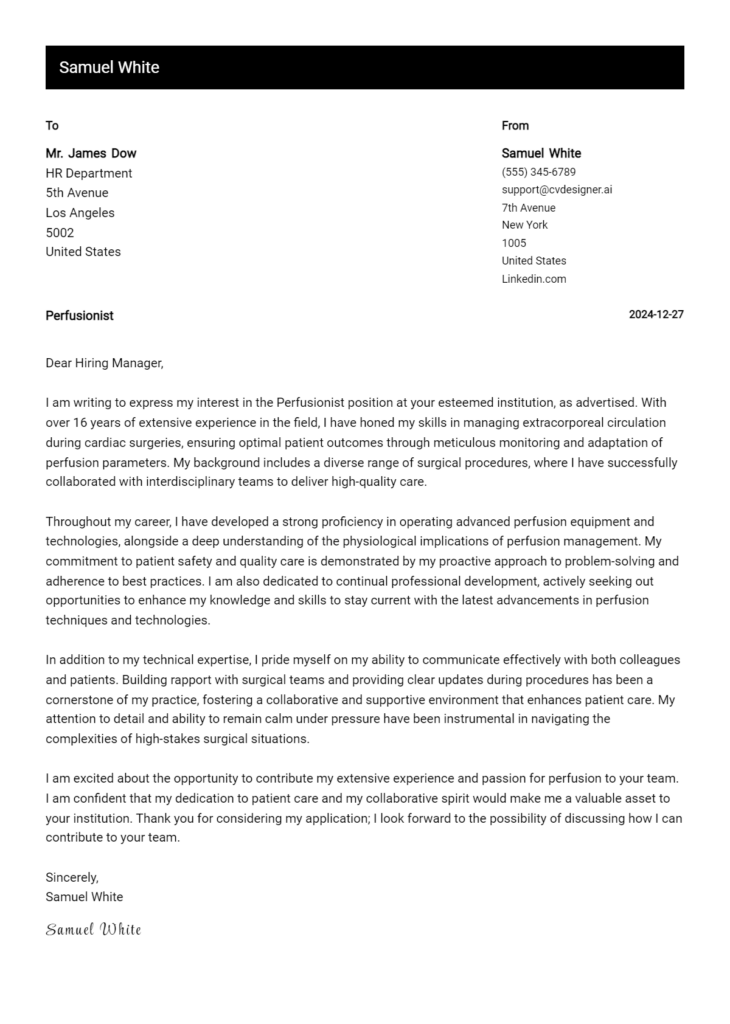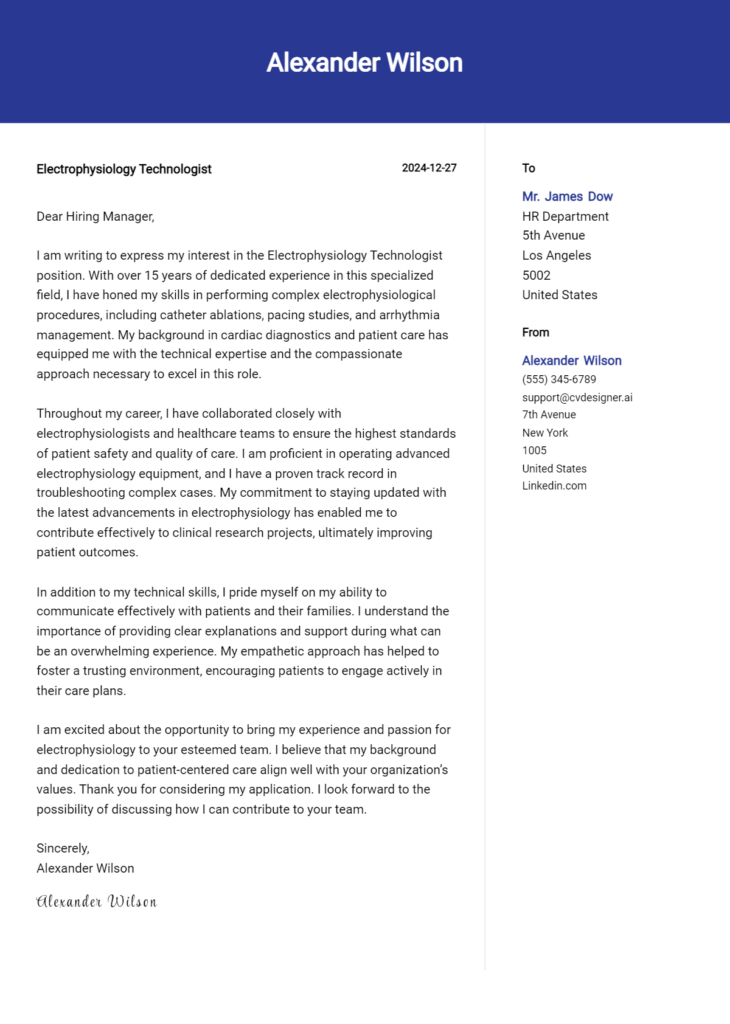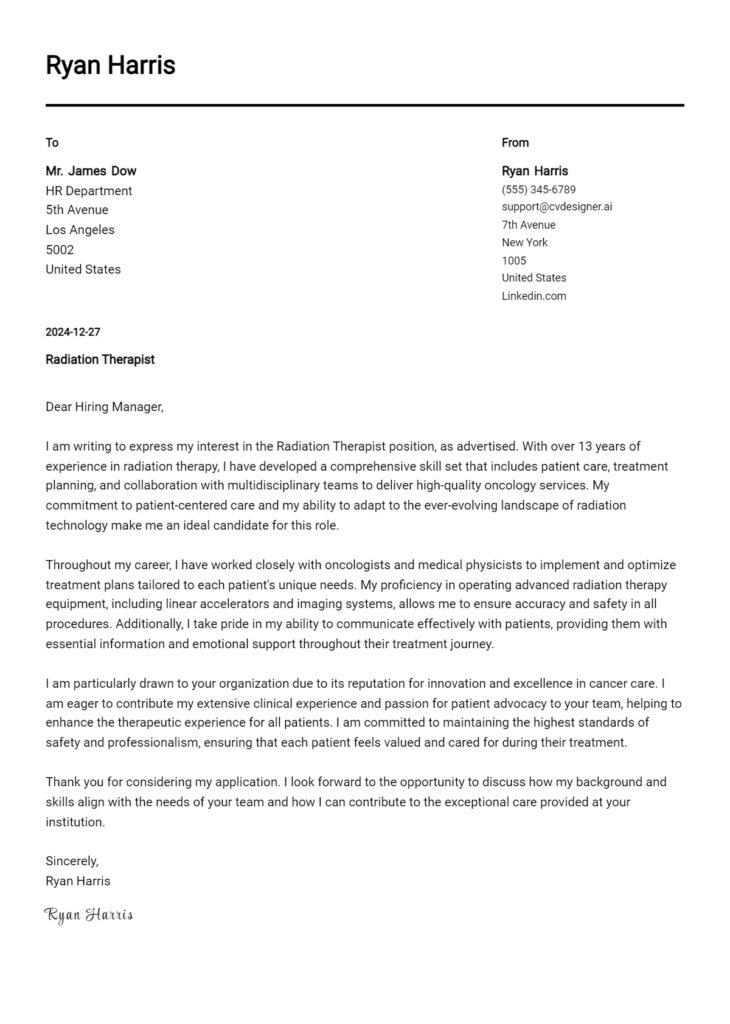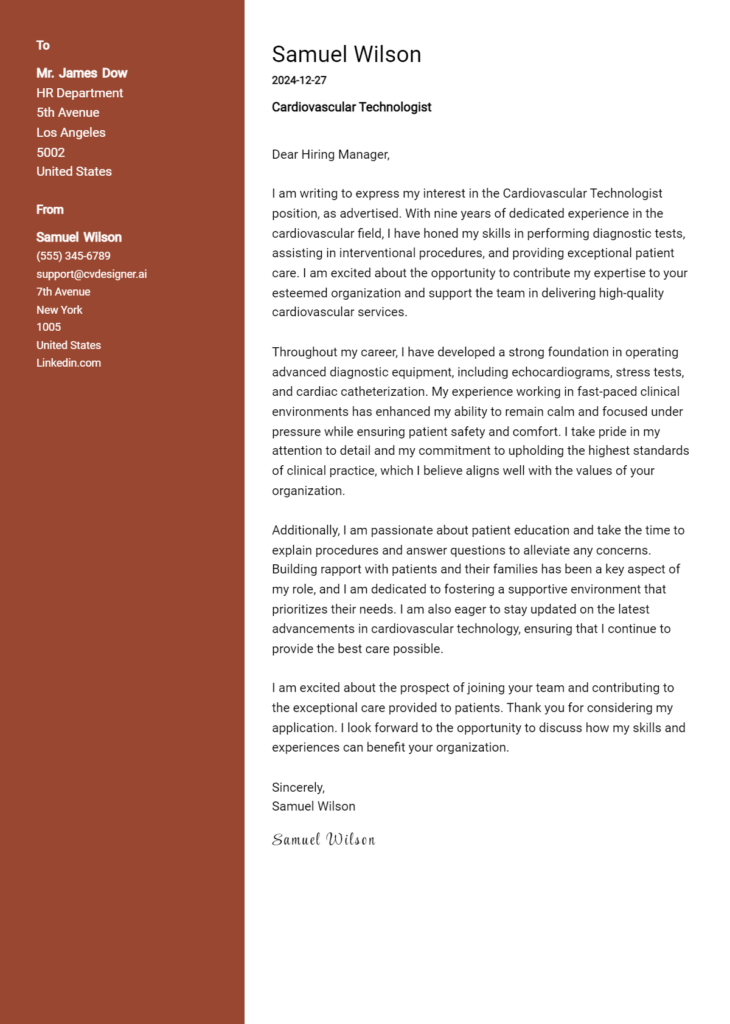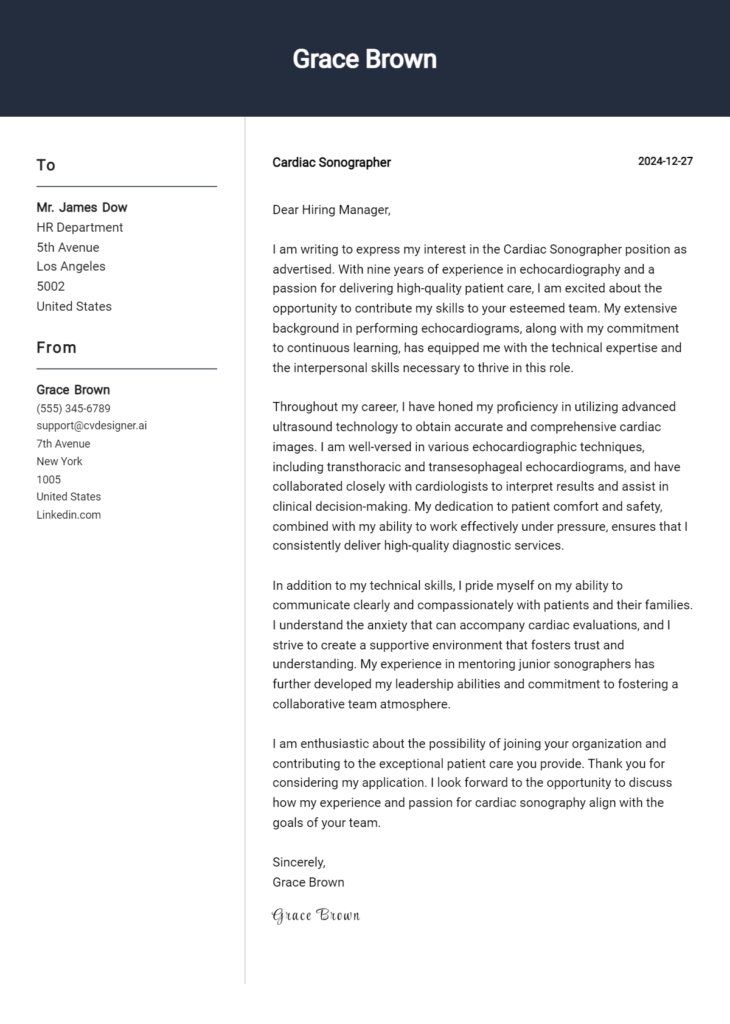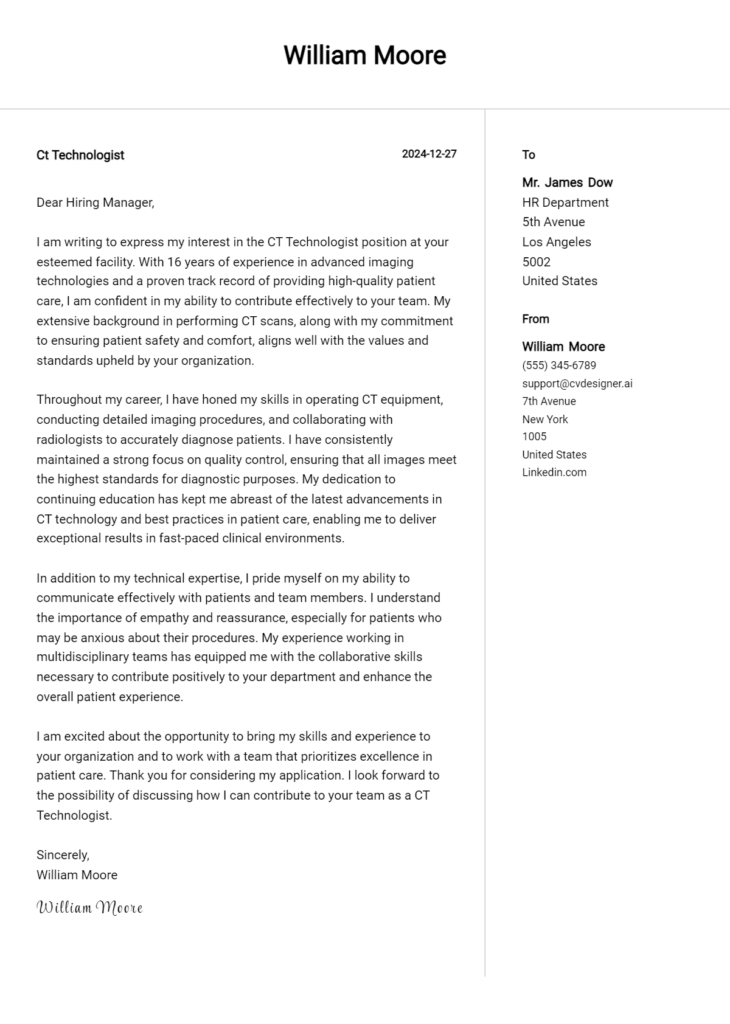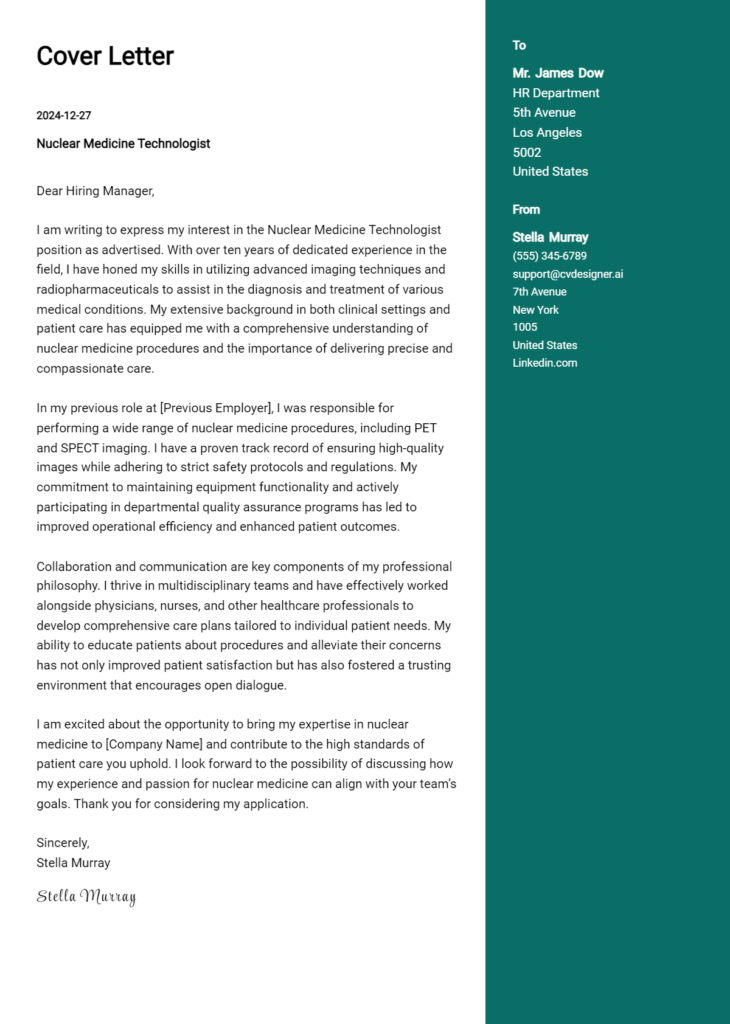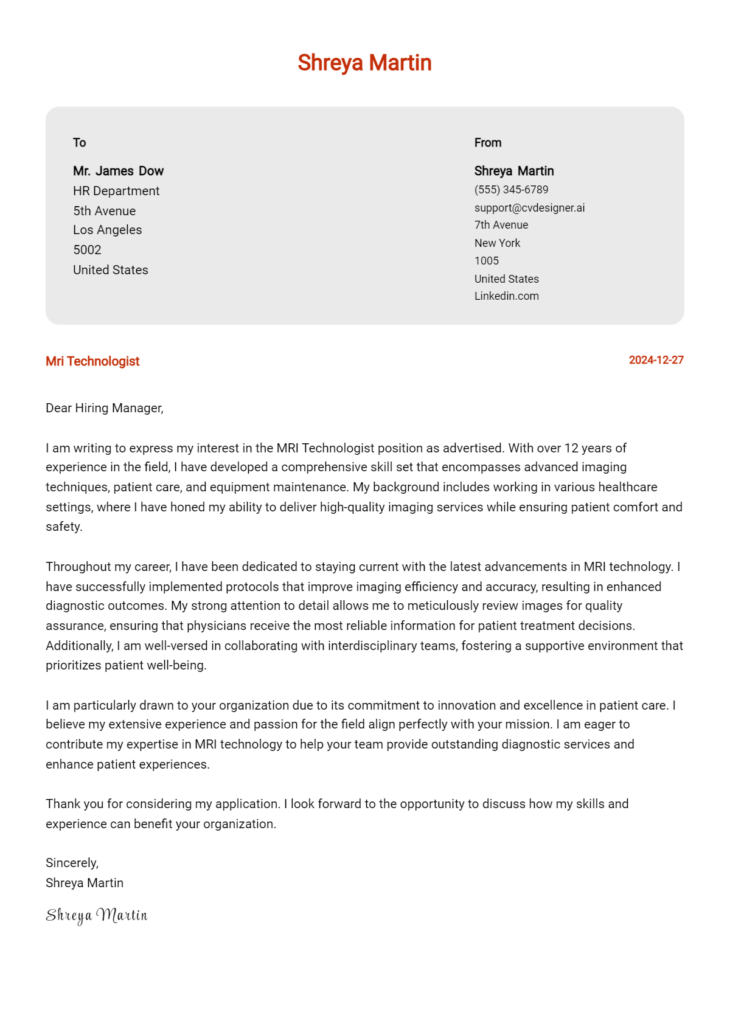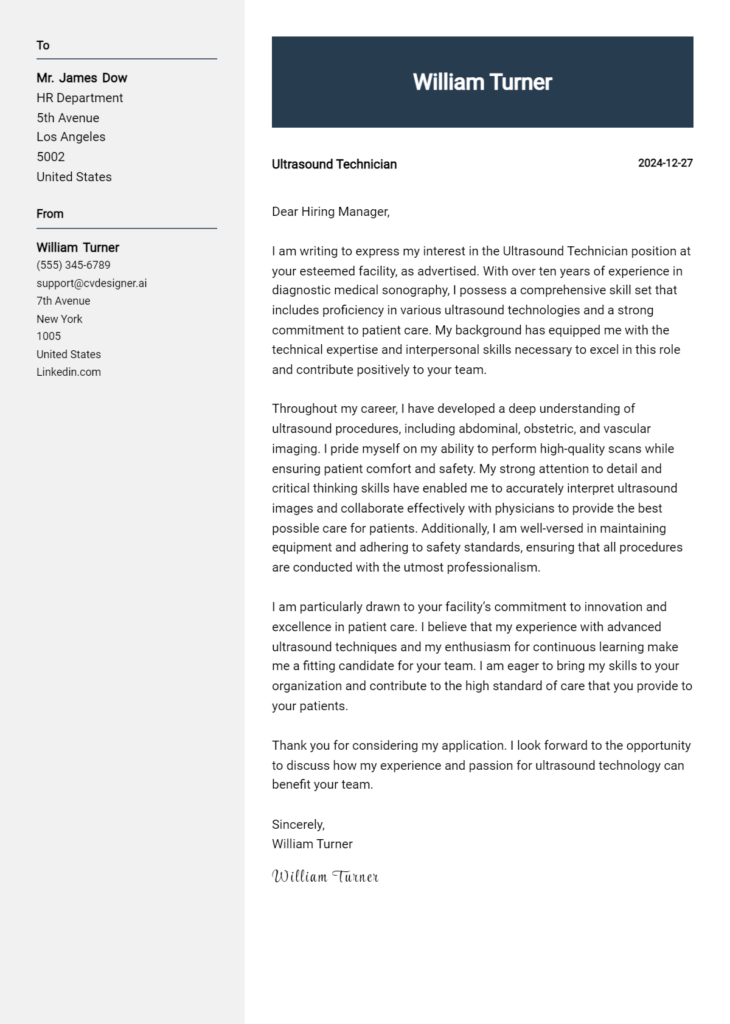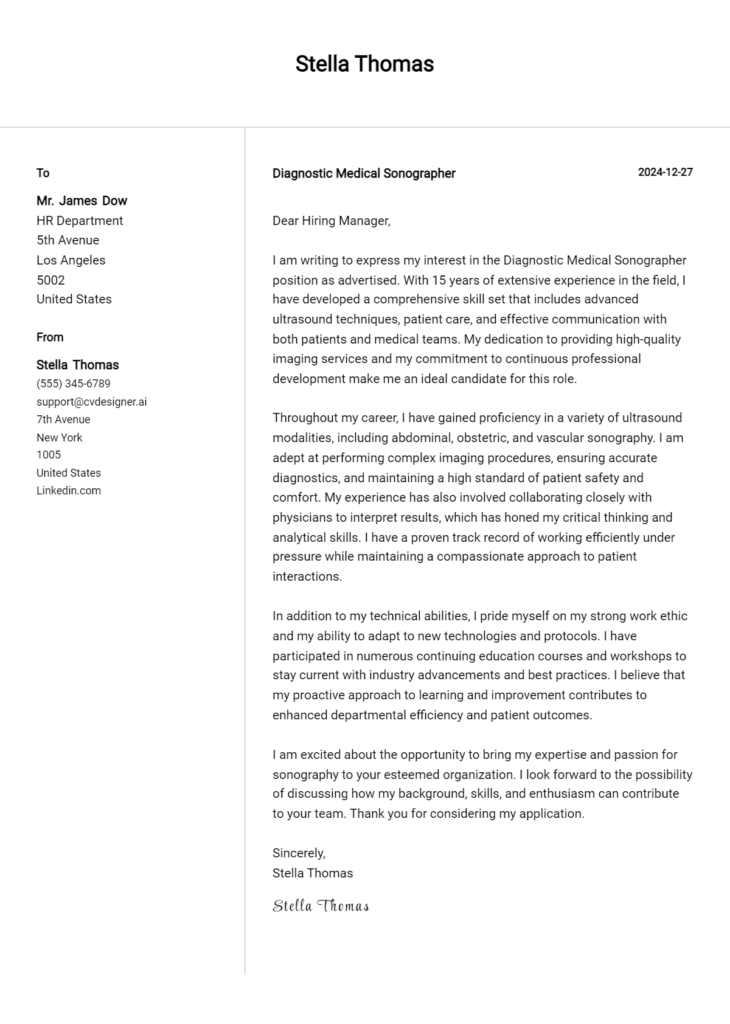Respiratory Care Practitioner Cover Letter Examples
Explore additional Respiratory Care Practitioner cover letter samples and guides and see what works for your level of experience or role.
How to Format a Respiratory Care Practitioner Cover Letter?
Crafting a well-structured cover letter is essential for a Respiratory Care Practitioner, as it not only highlights your qualifications but also demonstrates your ability to communicate effectively in a healthcare setting. The format you choose can reflect your professionalism and attention to detail, both of which are crucial traits in the field of respiratory care. A well-organized cover letter captures the hiring manager's attention and sets the tone for your application, showcasing your commitment to providing exceptional patient care.
In this guide, we will discuss how to structure your cover letter effectively, offering insights and examples tailored specifically for respiratory care practitioners.
We'll focus on the essential components of a professional cover letter, including:
- Cover Letter Header
- Cover Letter Greeting
- Cover Letter Introduction
- Cover Letter Body
- Cover Letter Closing
Each section is vital in presenting your qualifications and professionalism. Let’s break down each part to help you create a standout cover letter for your respiratory care career.
Importance of the Cover Letter Header for a Respiratory Care Practitioner
A well-structured cover letter header is crucial for a Respiratory Care Practitioner as it sets the tone for the entire letter and establishes professionalism. The header should include essential details such as your contact information, the date, and the recipient's details. Clarity is key—this information should be easy to read and organized logically. A polished header not only conveys your attention to detail but also ensures that the hiring manager can easily identify and contact you.
Here are examples of a strong and a weak cover letter header for a Respiratory Care Practitioner:
Strong Example
John Doe 123 Main Street City, State, ZIP (123) 456-7890 john.doe@email.com [Date] Hiring Manager Healthcare Facility Name 456 Elm Street City, State, ZIP
Weak Example
JD 123 St (123) 456-7890 Date To Whom It May Concern
In the strong example, the header is clear, complete, and easy to read, while the weak example lacks detail and professionalism, which could hinder the first impression.
The Importance of a Personalized Cover Letter Greeting
A well-crafted cover letter greeting is essential in setting the tone for the entire letter, as it serves as the first impression for the hiring manager. By directly addressing the recipient, you not only demonstrate professionalism but also show that you have taken the time to personalize your application. This attention to detail can distinguish you from other candidates. To avoid sounding generic, it’s crucial to research the hiring manager’s name, which can often be found on the company’s website or LinkedIn profile. A personalized greeting indicates your genuine interest in the position and respect for the reader's time.
Strong Greeting Example
Dear Mr. Smith,
Weak Greeting Example
To Whom It May Concern,
The Importance of a Compelling Cover Letter Introduction for a Respiratory Care Practitioner
A well-crafted cover letter introduction is vital for any Respiratory Care Practitioner seeking a new position. This initial paragraph serves as the first impression, capturing the hiring manager's attention and setting the tone for the rest of the letter. It should convey genuine interest in the role, highlight relevant qualifications, and showcase key skills or achievements that align with the job requirements. A strong introduction can effectively differentiate a candidate from the competition, while a weak one may fail to resonate, potentially leading to missed opportunities.
Strong Example
Dear [Hiring Manager's Name], As a dedicated and compassionate Respiratory Care Practitioner with over five years of experience in critical care settings, I am excited about the opportunity to contribute to [Company Name]. My background in managing complex respiratory conditions and my commitment to patient-centered care align perfectly with your team's mission to provide exceptional healthcare services. I have successfully implemented evidence-based protocols that improved patient outcomes by 20%, and I am eager to bring my expertise in ventilator management and patient education to your esteemed facility.
Weak Example
To whom it may concern, I am writing to apply for the Respiratory Care Practitioner position. I have worked in healthcare for a while and I think I would be a good fit for the job. I have some experience and can do various tasks related to respiratory care.
Purpose of the Cover Letter Body for a Respiratory Care Practitioner
The body of the cover letter for a Respiratory Care Practitioner serves as a critical opportunity for candidates to articulate their relevant skills, experiences, and the unique value they can bring to a healthcare organization. This section allows candidates to highlight specific projects or accomplishments that demonstrate their expertise in patient care and respiratory therapy techniques. By sharing success stories, such as improving patient outcomes through innovative treatment plans or implementing new protocols that enhance operational efficiency, candidates can effectively differentiate themselves from others in the field.
Strong Example
I am excited to apply for the Respiratory Care Practitioner position at [Company Name]. In my previous role at [Previous Employer], I successfully led a project that streamlined our ventilator management protocol, resulting in a 20% reduction in patient recovery time. My dedication to patient-centered care was recognized when I received the [Specific Award] for my role in improving patient satisfaction scores by implementing comprehensive education programs for patients and their families. I am confident that my hands-on experience with advanced respiratory technologies, along with my commitment to continuous learning, will enable me to make a meaningful contribution to your team.
Weak Example
I am applying for the Respiratory Care Practitioner position. I have worked in respiratory therapy for several years and have a good understanding of the field. I believe I can do a decent job at [Company Name]. I have helped some patients and have attended a few workshops. I hope to contribute positively to your organization, and I am looking forward to the opportunity.
Importance of the Cover Letter Closing for a Respiratory Care Practitioner
The closing of a cover letter is crucial as it summarizes your qualifications, reiterates your interest in the role, and encourages the hiring manager to take the next step, whether that be reviewing your resume or scheduling an interview. A strong closing leaves a lasting impression and reinforces your enthusiasm and suitability for the position, while a weak closing may undermine the positive points made earlier in the letter.
Strong Example
Thank you for considering my application for the Respiratory Care Practitioner position at [Company Name]. With my extensive background in respiratory therapy and my commitment to providing exceptional patient care, I am excited about the opportunity to contribute to your team. I look forward to the possibility of discussing how my skills and experiences align with the needs of your department. Please feel free to contact me to schedule an interview at your earliest convenience. I have attached my resume for your review. Thank you for your time and consideration.
Weak Example
I hope you look at my resume. I really want this job, and I think I could do okay. If you want to talk to me, you can call or email. Thanks, I guess.
Crafting a compelling cover letter is essential for candidates applying for the role of a Respiratory Care Practitioner. This document serves as a first impression, allowing you to highlight your technical skills, problem-solving abilities, knowledge of the software development life cycle (SDLC), teamwork, and commitment to continuous learning. By effectively showcasing these attributes, you can stand out in a competitive job market. Here are five detailed tips to help you create an impactful cover letter:
Tips for Writing a Cover Letter for Respiratory Care Practitioner
Highlight Technical Skills: Make sure to emphasize your technical competencies relevant to respiratory care, such as proficiency in operating ventilators, administering respiratory therapies, and interpreting diagnostic tests. Use specific examples from your previous experience to demonstrate your expertise. This not only reassures employers of your capabilities but also aligns your skills with the job requirements.
Showcase Problem-Solving Abilities: Respiratory Care Practitioners often face complex patient challenges. Illustrate your problem-solving skills by sharing a brief story about a situation where you successfully identified a problem and implemented an effective solution. This can be a great way to convey your critical thinking and adaptability, qualities that are highly valued in healthcare settings.
Demonstrate Knowledge of SDLC: If your role involves working with healthcare technologies or software, it's important to mention your understanding of the Software Development Life Cycle (SDLC). Discuss any experience you have with technology integration in respiratory care and how it enhances patient outcomes. This will show your technical aptitude and your ability to work in a technologically evolving environment.
Emphasize Teamwork: Collaboration is key in healthcare, so highlight your ability to work effectively within a multidisciplinary team. Provide examples of how you have contributed to a team effort, whether by sharing knowledge, supporting colleagues, or participating in joint decision-making processes. This illustrates your interpersonal skills and reinforces your fit for the role.
Express Passion for Continuous Learning: The field of respiratory care is constantly evolving with new techniques and technologies. Convey your commitment to professional development by mentioning any relevant certifications, ongoing education, or participation in workshops and conferences. This shows potential employers that you are dedicated to staying current in your field and improving your skills continuously.
By incorporating these tips into your cover letter, you can create a strong narrative that showcases your qualifications and enthusiasm for the role. For additional assistance, consider exploring various cover letter templates or using a cover letter builder to streamline the writing process. Good luck!
Common Mistakes to Avoid in a Respiratory Care Practitioner Cover Letter
Avoiding common mistakes in a cover letter is crucial for making a strong first impression as a Respiratory Care Practitioner. Many candidates inadvertently undermine their chances by overlooking key aspects of their cover letter. Here are some frequent pitfalls to avoid:
- Generic Greetings: Using “To Whom It May Concern” shows a lack of effort. Address the hiring manager by name whenever possible.
- Neglecting to Tailor the Content: A one-size-fits-all approach can be detrimental. Customize your cover letter for each job application by highlighting relevant skills and experiences specific to the position.
- Focusing on Duties Instead of Achievements: Instead of listing job duties, emphasize your accomplishments and how they benefited previous employers. This showcases your value.
- Ignoring Formatting Guidelines: Poor formatting can make your cover letter hard to read. Follow proper cover letter format to ensure clarity and professionalism.
- Typos and Grammatical Errors: Simple mistakes can undermine your credibility. Always proofread your letter or ask someone else to review it before submission.
- Overly Lengthy Content: Aim for brevity while still being informative. A cover letter should ideally be one page, succinctly summarizing your qualifications.
- Missing a Call to Action: Failing to express interest in an interview can leave your application flat. End with a strong statement that invites further discussion about your candidacy.
For more guidance, check out these cover letter examples to inspire your writing!
Cover Letter FAQs for Respiratory Care Practitioner
What should I include in my cover letter as a Respiratory Care Practitioner?
Your cover letter should begin with a strong opening that introduces you and specifies the position you're applying for. Include your qualifications, such as your degree and certifications (e.g., RRT or CRT), and highlight your relevant experience in respiratory care settings. Discuss specific skills, such as your proficiency in ventilator management, patient assessments, and familiarity with emergency protocols. Additionally, mention any accomplishments that showcase your ability to improve patient outcomes. Finally, express your enthusiasm for the role and how you align with the institution's mission, emphasizing your commitment to providing high-quality patient care.
How can I tailor my cover letter for a specific job application?
To tailor your cover letter, start by researching the organization and the specific role you’re applying for. Identify key responsibilities and qualifications listed in the job description. Use this information to highlight relevant experiences from your background that directly relate to those requirements. Incorporate specific terminology from the job posting to demonstrate your understanding of the role. Additionally, mention any connections you have with the organization, such as shared values or previous work experiences. This personalized approach shows your genuine interest in the position and helps you stand out among other applicants.
How long should my cover letter be?
Your cover letter should ideally be one page in length, typically ranging from three to five paragraphs. Each paragraph should serve a specific purpose: the opening introduces you and the position, the body paragraphs detail your qualifications and experience, and the closing reinforces your interest and invites further communication. Aim to be concise and focused—employing clear language and avoiding unnecessary jargon. Remember, hiring managers often review numerous applications, so a well-structured and succinct cover letter is more likely to grab their attention and make a lasting impression.
Should I include my resume with my cover letter?
Yes, you should always include your resume when submitting a cover letter for a Respiratory Care Practitioner position. The cover letter serves as a personalized introduction that complements your resume, allowing you to elaborate on your qualifications and experiences. Ensure that your resume is formatted professionally and aligns with the key points you highlight in your cover letter. When submitting, mention in your cover letter that your resume is attached, making it easy for the hiring manager to locate both documents. This combination provides a comprehensive view of your candidacy and reinforces your professionalism.
Build your Cover Letter in minutes
Use an AI-powered cover letter builder and have your letter done in 5 minutes. Just select your template and our software will guide you through the process.

